英语时态(初中英语动词时态归纳总结对照表)
- 格式:docx
- 大小:112.15 KB
- 文档页数:13
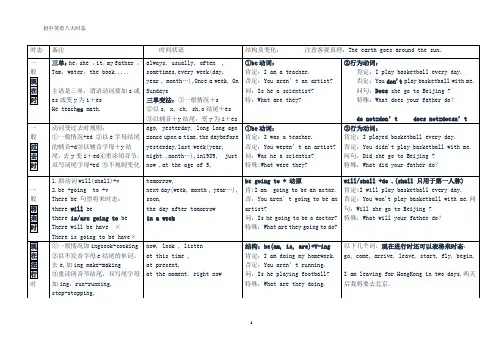
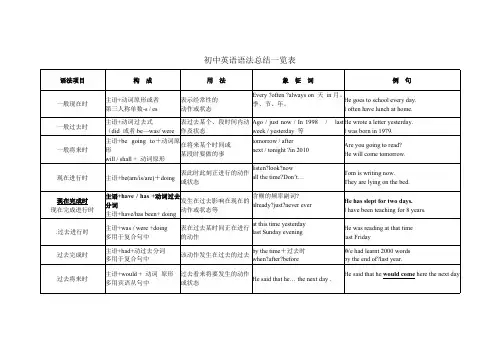
初中英语语法总结一览表语法项目构成用法象征词例句一般现在时主语+动词原形或者第三人称单数-s / es表示经常性的动作或状态Every ?often ?always on 天in月、季、节、年。
He goes to school every day.I often have lunch at home.一般过去时主语+动词过去式(did 或者be—was/ were表过去某个、段时间内动作及状态Ago / just now / In 1998 / lastweek / yesterday 等He wrote a letter yesterday.I was born in 1979.一般将来时主语+be going to+动词原形will / shall + 动词原形在将来某个时间或某段时要做的事tomorrow / afternext / tonight ?in 2010Are you going to read?He will come tomorrow.现在进行时主语+be(am/is/are)+doing 表此时此刻正进行的动作或状态listen?look?nowall the time?Don’t…Tom is writing now.They are lying on the bed.现在完成时现在完成进行时主语+have / has +动词过去分词主语+have/has been+ doing发生在过去影响在现在的动作或状态等含糊的频率副词?already?just?never everHe has slept for two days.I have been teaching for 8 years..过去进行时主语+was / were +doing多用于复合句中表在过去某时间正在进行的动作at this time yesterdaylast Sunday eveningHe was reading at that timelast Friday过去完成时主语+had+动过去分词多用于复合句中该动作发生在过去的过去by the time+过去时when?after?beforeWe had learnt 2000 wordsby the end of?last year.过去将来时主语+would + 动词原形多用宾语从句中过去看来将要发生的动作或状态He said that he… the next day .He said that he would come here the next day.。
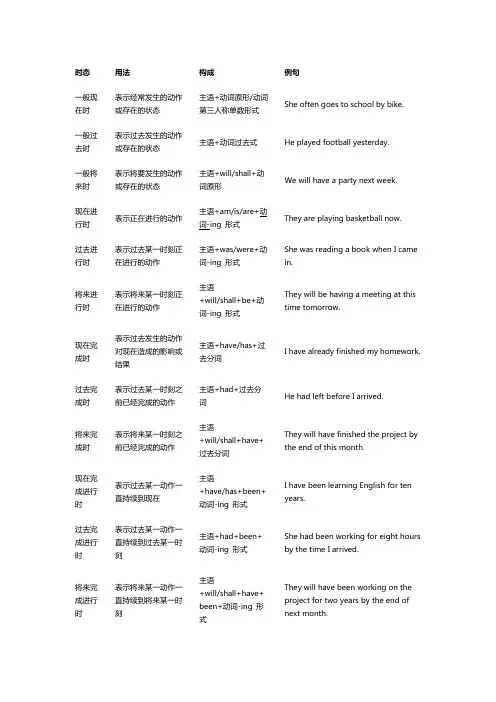
一般现在时表示经常发生的动作或存在的状态主语+动词原形/动词第三人称单数形式She often goes to school by bike.一般过去时表示过去发生的动作或存在的状态主语+动词过去式He played football yesterday.一般将来时表示将要发生的动作或存在的状态主语+will/shall+动词原形We will have a party next week.现在进行时表示正在进行的动作主语+am/is/are+动词-ing 形式They are playing basketball now.过去进行时表示过去某一时刻正在进行的动作主语+was/were+动词-ing 形式She was reading a book when I camein.将来进行时表示将来某一时刻正在进行的动作主语+will/shall+be+动词-ing 形式They will be having a meeting at thistime tomorrow.现在完成时表示过去发生的动作对现在造成的影响或结果主语+have/has+过去分词I have already finished my homework.过去完成时表示过去某一时刻之前已经完成的动作主语+had+过去分词He had left before I arrived.将来完成时表示将来某一时刻之前已经完成的动作主语+will/shall+have+过去分词They will have finished the project bythe end of this month.现在完成进行时表示过去某一动作一直持续到现在主语+have/has+been+动词-ing 形式I have been learning English for tenyears.过去完成进行时表示过去某一动作一直持续到过去某一时刻主语+had+been+动词-ing 形式She had been working for eight hoursby the time I arrived.将来完成进行时表示将来某一动作一直持续到将来某一时刻主语+will/shall+have+been+动词-ing 形式They will have been working on theproject for two years by the end ofnext month.过去将来时表示过去某一时刻之后将要发生的动作主语+would/should+动词原形He said he would come back the nextday.过去将来进行时表示过去某一时刻之后将要进行的动作主语+would/should+be+动词-ing 形式She said she would be working on theproject at that time.过去将来完成时表示过去某一时刻之后将要完成的动作主语+would/should+have+过去分词He said he would have finished thework by the end of the week.。
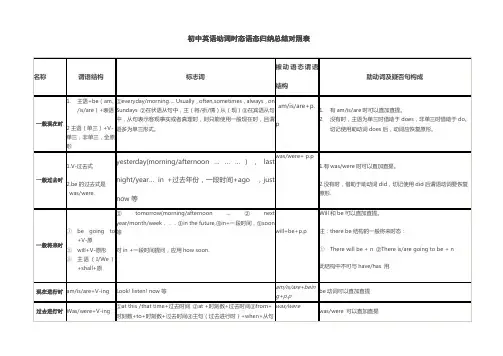
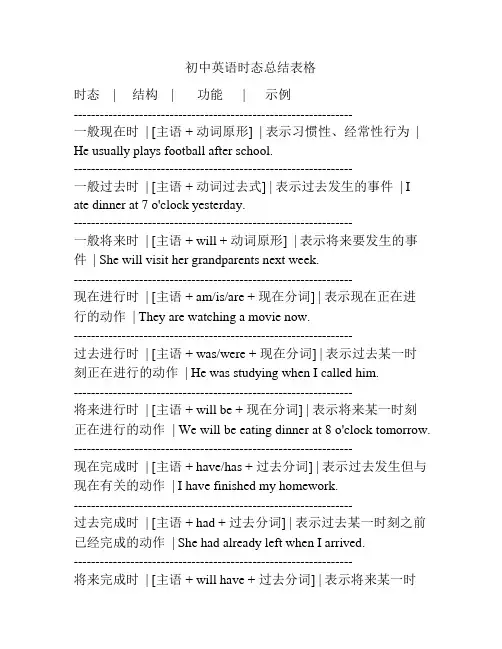
初中英语时态总结表格时态 | 结构 | 功能 | 示例----------------------------------------------------------------一般现在时 | [主语 + 动词原形] | 表示习惯性、经常性行为 | He usually plays football after school.----------------------------------------------------------------一般过去时 | [主语 + 动词过去式] | 表示过去发生的事件 | I ate dinner at 7 o'clock yesterday.----------------------------------------------------------------一般将来时 | [主语 + will + 动词原形] | 表示将来要发生的事件 | She will visit her grandparents next week.----------------------------------------------------------------现在进行时 | [主语 + am/is/are + 现在分词] | 表示现在正在进行的动作 | They are watching a movie now.----------------------------------------------------------------过去进行时 | [主语 + was/were + 现在分词] | 表示过去某一时刻正在进行的动作 | He was studying when I called him.----------------------------------------------------------------将来进行时 | [主语 + will be + 现在分词] | 表示将来某一时刻正在进行的动作 | We will be eating dinner at 8 o'clock tomorrow. ----------------------------------------------------------------现在完成时 | [主语 + have/has + 过去分词] | 表示过去发生但与现在有关的动作 | I have finished my homework.----------------------------------------------------------------过去完成时 | [主语 + had + 过去分词] | 表示过去某一时刻之前已经完成的动作 | She had already left when I arrived.----------------------------------------------------------------将来完成时 | [主语 + will have + 过去分词] | 表示将来某一时刻之前已经完成的动作 | By this time next year, we will have graduated from high school.----------------------------------------------------------------情态动词 | [情态动词 + 动词原形] | 表示能力、意愿、推测等 | She can swim very well.----------------------------------------------------------------。

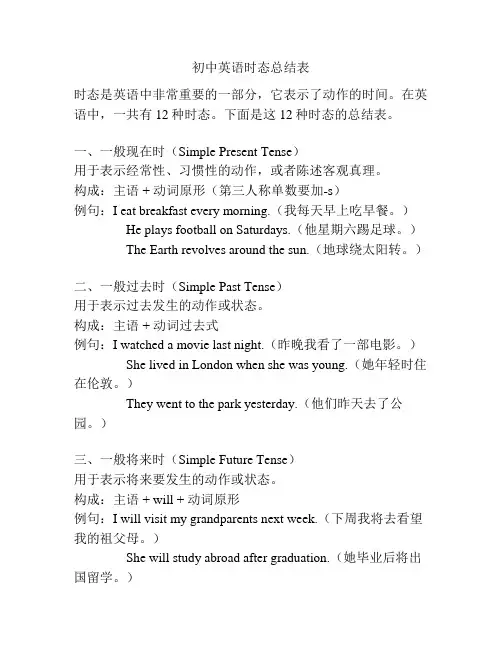
初中英语时态总结表时态是英语中非常重要的一部分,它表示了动作的时间。
在英语中,一共有12种时态。
下面是这12种时态的总结表。
一、一般现在时(Simple Present Tense)用于表示经常性、习惯性的动作,或者陈述客观真理。
构成:主语 + 动词原形(第三人称单数要加-s)例句:I eat breakfast every morning.(我每天早上吃早餐。
)He plays football on Saturdays.(他星期六踢足球。
)The Earth revolves around the sun.(地球绕太阳转。
)二、一般过去时(Simple Past Tense)用于表示过去发生的动作或状态。
构成:主语 + 动词过去式例句:I watched a movie last night.(昨晚我看了一部电影。
)She lived in London when she was young.(她年轻时住在伦敦。
)They went to the park yesterday.(他们昨天去了公园。
)三、一般将来时(Simple Future Tense)用于表示将来要发生的动作或状态。
构成:主语 + will + 动词原形例句:I will visit my grandparents next week.(下周我将去看望我的祖父母。
)She will study abroad after graduation.(她毕业后将出国留学。
)They will have a party on Friday.(他们将在星期五举行一个派对。
)四、现在进行时(Present Continuous Tense)用于表示现在正在进行的动作。
构成:主语 + am/is/are + 现在分词(-ing形式)例句:I am reading a book now.(我现在在读一本书。
)She is playing the piano at the moment.(她此刻正在弹钢琴。
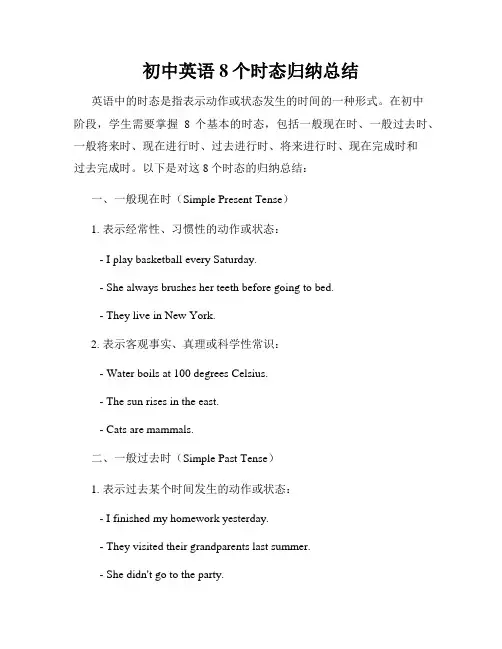
初中英语8个时态归纳总结英语中的时态是指表示动作或状态发生的时间的一种形式。
在初中阶段,学生需要掌握8个基本的时态,包括一般现在时、一般过去时、一般将来时、现在进行时、过去进行时、将来进行时、现在完成时和过去完成时。
以下是对这8个时态的归纳总结:一、一般现在时(Simple Present Tense)1. 表示经常性、习惯性的动作或状态:- I play basketball every Saturday.- She always brushes her teeth before going to bed.- They live in New York.2. 表示客观事实、真理或科学性常识:- Water boils at 100 degrees Celsius.- The sun rises in the east.- Cats are mammals.二、一般过去时(Simple Past Tense)1. 表示过去某个时间发生的动作或状态:- I finished my homework yesterday.- They visited their grandparents last summer.- She didn't go to the party.2. 表示过去的经历或习惯:- When I was young, I often went swimming. - He always ate breakfast at 8 o'clock.三、一般将来时(Simple Future Tense)1. 表示将来要发生的动作或事件:- I will go shopping tomorrow.- They are going to have a picnic next week. - She won't be late for the meeting.2. 表示将来的打算或意愿:- I am going to be a doctor when I grow up.- We will help you with your project.四、现在进行时(Present Continuous Tense)1. 表示现在正在进行的动作:- We are studying English at the moment.- He is playing soccer with his friends.- They aren't watching TV right now.2. 表示现阶段的趋势或变化:- The population is increasing rapidly.- More and more people are using smartphones.五、过去进行时(Past Continuous Tense)1. 表示过去某一时间段内正在进行的动作:- I was reading a book when the phone rang.- They were cooking dinner at 7 o'clock.2. 表示过去的同时发生的两个动作:- She was listening to music while doing her homework.六、将来进行时(Future Continuous Tense)1. 表示将来某一时间段内正在进行的动作:- Tomorrow, they will be flying to Paris.- I will be waiting for you at the station.2. 表示将来的预测或计划:- This time next month, I will be studying for my exams.七、现在完成时(Present Perfect Tense)1. 表示过去某一时间发生的动作对现在造成的影响或结果: - I have finished my homework, so I can watch TV now.- She has already eaten lunch.2. 表示过去某一时间内多次发生的动作:- We have visited that museum several times.八、过去完成时(Past Perfect Tense)1. 表示过去某一时间点之前已经完成的动作:- By the time they arrived, we had already left.- I had finished my work before the deadline.2. 表示过去的顺序或先后关系:- She realized that she had forgotten her keys after she locked the door.以上是初中英语的8个时态的归纳总结。
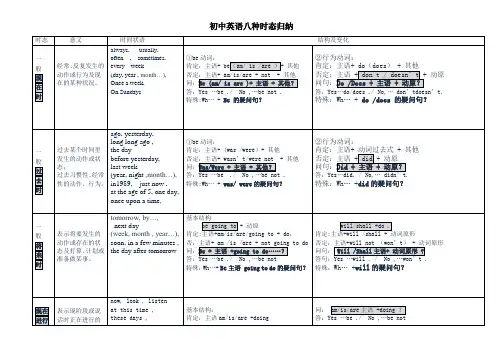
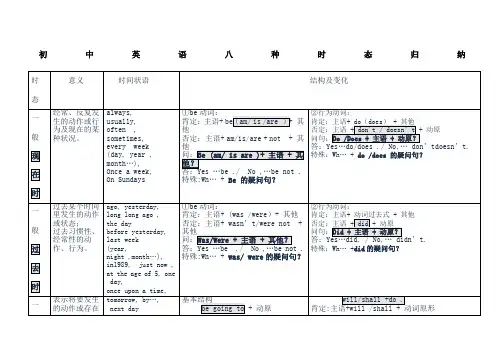
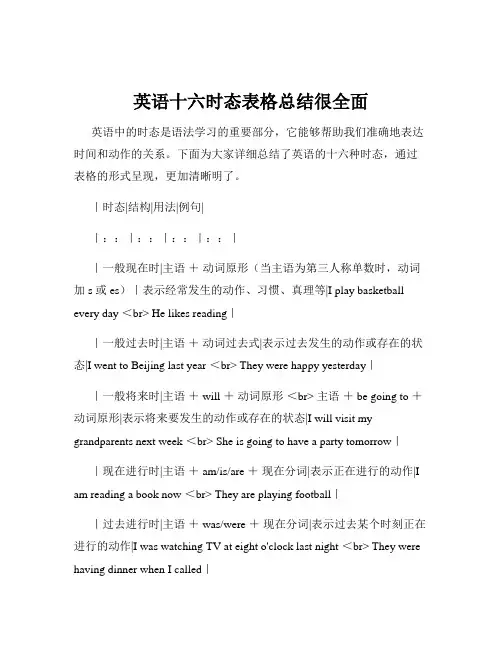
英语十六时态表格总结很全面英语中的时态是语法学习的重要部分,它能够帮助我们准确地表达时间和动作的关系。
下面为大家详细总结了英语的十六种时态,通过表格的形式呈现,更加清晰明了。
|时态|结构|用法|例句||::|::|::|::||一般现在时|主语+动词原形(当主语为第三人称单数时,动词加 s 或 es)|表示经常发生的动作、习惯、真理等|I play basketball every day <br> He likes reading||一般过去时|主语+动词过去式|表示过去发生的动作或存在的状态|I went to Beijing last year <br> They were happy yesterday||一般将来时|主语+ will +动词原形<br> 主语+ be going to +动词原形|表示将来要发生的动作或存在的状态|I will visit my grandparents next week <br> She is going to have a party tomorrow||现在进行时|主语+ am/is/are +现在分词|表示正在进行的动作|I am reading a book now <br> They are playing football||过去进行时|主语+ was/were +现在分词|表示过去某个时刻正在进行的动作|I was watching TV at eight o'clock last night <br> They were having dinner when I called|be +现在分词|表示将来某个时刻正在进行的动作|I will be sleeping at this time tomorrow <br> They are going to be working at nine o'clock tomorrow morning||现在完成时|主语+ have/has +过去分词|表示过去发生的动作对现在造成的影响或结果,或过去的动作一直持续到现在|I have finished my homework <br> He has lived here for ten years||过去完成时|主语+ had +过去分词|表示过去某个时间之前已经完成的动作|I had learned 500 words before I entered this school <br> By the end of last year, she had written three novels||将来完成时|主语+ will have +过去分词<br> 主语+ be going to have +过去分词|表示到将来某个时间为止将会完成的动作|By the time you come back, I will have finished the work <br> They are going to have built the bridge by the end of next month||现在完成进行时|主语+ have/has been +现在分词|表示从过去某时开始一直持续到现在的动作,并且还将继续下去|I have been waiting for you for two hours <br> She has been studying English since 2010||过去完成进行时|主语+ had been +现在分词|表示过去某一时间之前一直在进行的动作|He had been waiting for her for two hours when she arrived <br> They had been working on the project for a week before I joined them|be going to have been +现在分词|表示将来某一时间之前一直持续的动作,并可能继续下去|By the end of next year, I will have been teaching for ten years <br> They are going to have been waiting for an hour by the time the bus arrives||过去将来时|主语+ would +动词原形<br> 主语+ was/were going to +动词原形|表示从过去的某个时间看将要发生的动作|He said he would come the next day <br> I knew she was going to buy a new car||过去将来进行时|主语+ would be +现在分词<br> 主语+was/were going to be +现在分词|表示从过去某时看将来某时正在进行的动作|He said he would be working at this time the next day <br> I thought she was going to be sleeping at nine o'clock||过去将来完成时|主语+ would have +过去分词<br> 主语+was/were going to have +过去分词|表示从过去看将来某时前已经完成的动作|He said he would have finished the work by the end of the month <br> I thought she was going to have bought the dress before her birthday||过去将来完成进行时|主语+ would have been +现在分词<br> 主语+ was/were going to have been +现在分词|表示从过去某时看将来某时之前一直在进行的动作|He said he would have been waiting for her for two hours by six o'clock <br> I thought she was going to have been studying for three hours by then|需要注意的是,时态的掌握需要不断的积累和练习,不能仅仅依靠死记硬背。
初中英语时态归纳总结英语时态是英语学习的重点和难点,尤其在初中阶段,掌握各种时态对于提高英语水平至关重要。
本文将对初中阶段需要掌握的英语时态进行归纳总结,帮助大家更好地理解和运用。
一、一般现在时1.动词原形:He likes playing football.2.动词三单:She studies English every day.3.现在进行时:They are watching TV now.4.每日习惯:I wake up at 6 o"clock every morning.二、一般过去时1.动词过去式:He visited his grandparents last week.2.过去进行时:They were playing chess when I came in.3.过去完成时:She had finished her homework before dinner.三、一般将来时1.动词原形:I will go to the library tomorrow.2.be going to:He is going to travel to Japan next month.3.现在进行时表将来:The plane is taking off in 10 minutes.四、现在进行时1.动词现在分词:She is reading a book.2.与always, constantly等词连用,表示频繁发生:My brother is always playing video games.五、过去进行时1.动词过去分词:They were discussing the project.2.与at that time, at this moment等词连用,表示在某个时间正在进行的动作:At that time, she was sleeping.六、完成时1.现在完成时:I have finished my homework.2.过去完成时:He had left the classroom before I arrived.七、被动语态1.一般现在时:The book is written by him.2.一般过去时:The window was broken by Tom.3.一般将来时:The letter will be sent to her tomorrow.总结:初中英语时态的学习需要掌握一般现在时、一般过去时、一般将来时、现在进行时、过去进行时、完成时和被动语态等。
初中英语语法⼋⼤时态总结(完整版)初中英语语法⼋⼤时态⼀.⼀般现在时1. 结构肯定句式:主语+动词原形/动词的第三⼈称单数+其他否定句式:主语+ (助动词)don't/doesn't +动词原形+其他⼀般疑问句式:Do/Does+主语+动词原形+其他简略回答:(肯)Yes,主语+do/does (否)No,主语+do/does not缩写形式: don't = do not does n't = does not例句:He often goes swimming in summer.I usually leave home for school at 7 every morning.1)表⽰经常的、习惯性的动作或存在的状态,常与表⽰频度的副词连⽤。
常⽤的频度副词有:always、often、usually、seldom、never、sometimes, every week (day, year, month …),once a week, on Su nday频度副词在句中通常放在⾏为动词之前,系动词、助动词之后。
例⼥⼝: He often goes swimming in summer.I usually leave home for school at 7 every morning.2)表⽰主语具备的性格、特征和能⼒等。
例如:All my family love football .My sister is always ready to help others .Ann writes good En glish but does not speak well.3)表⽰客观真理、客观存在、⾃然现象。
例如:The earth moves around the sun.Shan ghai lies in the east of China.4)表⽰按计划或安排好的,或将要发⽣的动作,可⽤⼀般现在时表将来。
英语8大时态总结表格时态概述英语中有8大时态,它们用于表达不同时间和状态。
下面是关于这些时态的详细总结表格。
时态结构用法一般现在时主语 + 动词原形表示经常性、习惯性或普遍真理一般过去时主语 + 动词过去式表示过去发生的动作或状态一般将来时主语 + will + 动词原形表示将来发生的动作或状态现在进行时主语 + be + 动词-ing 表示现在进行的动作或状态过去进行时主语 + was/were + 动词-ing 表示过去某一时间正在进行的动作将来进行时主语 + will be + 动词-ing 表示将来某一时间正在进行的动作现在完成时主语 + have/has + 过去分词表示过去某一时间到现在的持续动作过去完成时主语 + had + 过去分词表示过去某一时间到过去的持续动作详细解释一般现在时一般现在时表示经常性、习惯性或普遍真理。
它的结构是主语 + 动词原形。
例如:•I go to school every day.•She likes to read books.•The sun rises in the east.一般过去时一般过去时表示过去发生的动作或状态。
它的结构是主语+ 动词过去式。
例如:•I went to the park yesterday.•They played soccer last week.•She bought a new car two years ago.一般将来时一般将来时表示将来发生的动作或状态。
它的结构是主语 + will + 动词原形。
例如:•I will travel to Japan next month.•They will have a party tomorrow.•She will call you later.现在进行时现在进行时表示现在正在进行的动作或状态。
它的结构是主语+ be + 动词-ing。
例如:•I am studying for the exam.•She is watching TV right now.•They are playing basketball in the park.过去进行时过去进行时表示过去某一时间正在进行的动作。
初中英语八大时态
一般现在时:am/is/are + 动词原形
一般过去时:was/were + 动词的过去式
现在进行时:am/is/are + 动词的现在分词
过去进行时:was/were + 动词的现在分词
一般将来时:will + 动词原形
过去将来时:助动词would + 动词原形或was/were going to + 动词原形
现在完成时:助动词have/has + 动词的过去分词
过去完成时:助动词had + 动词的过去分词
一般现在时:every day,week,mouth,year,always,usually,often,sometimes,seldom 一般过去时:yesterday,the day,before,yesterday,just,now,ago,last week
现在进行时:now,these days,this week,all the time
过去进行时:at the day,then,this time yesterday,the hole morning
一般将来时:tomorrow,the day after tomorrow,next time,from now on,later (on),soon 过去将来时:the next day,the following week,soon,one day,in a week
现在完成时:already,yet,never,so far,since,before。
名用法称一1. 此刻的状态般2. 经常性或习现惯性的动作在3. 主语具备的时性格或能力一 1. 过去某时发生的动作或存般在的状态过2.过去经常或去屡次发生的动时作一 1. 将来某时间要发生的动或般存在的状态将2.将来经常或来屡次发生的时动作初中英语动词时态归纳总结比较表动词形式 ( 以 do为例 )常用时间状语in the morning/afternoon/morningI/We/You/They do...every day/morning/SundayHe/She/It does...on Sunayalways usually oftensometimesI/We did...yesterday(morning/afternoon)You st night/Sunday in 1990He/She/It did...two days ago alwaysThey ually often sometimesI shall do...I'm going to do...We/You/They/He/She/tomorrowIt will do...(morning/afternoon/We/You/They areevening)goingnext year/month/weekto do...He/She/It is going todo...例句1.She is twelve.2.I get up at 6:30 everyday.3.She likes swimming.1.I got up at 6:30yesterday.2.He always went to workby bus last year.1.I will go to my home townnext week.2.I'll come to see youevery Sunday.3.I'm going to swimtomorrow afternoon.现在此刻或当前一段时间内正在进进行或发生的行动作时过去过去某一时辰进或某一段正内前进行的动作时现1. 过去发生或在已经完成的某I'm doing...He/She/It is doing...We/You/Theyare doing...I/He/She/It was doing...We/You/They weredoing....He/She/It has done...We/You/They havenowthis time yesterdayat ten o'clock yesterdayat that timewhen he came backalready just before neverfor three years1.She is watering theflowers.2.Are they working now?3.They are listening to theteacher.1.We were reading in classthis time yesterday2.I was drawing a picturewhen the teachercame in.1.I've already posted theletter.完一动作对此刻成造成的影响或结果时2.表示过去已经开始并连续到此刻的动作或状态过去过去某一时间完前已经发后的成动作或状态时现此刻以前的一在段时间里素来完进行的动作, 成这个运作可能进仍在进行 ,也可能连续进行行下去时done...I/We/You/He/She/Ithad done .I/We/You/They havebeen doing .He/She/It has beendoing .since 1990this morningthese daysby the end o fwhen+一般过去时before+一般过去时since nine o’ clockfor five hours2.We have known eachother for ten years.3.They lived here since1997.4.Have you ever been toBeijing?1.I had learned 2000 wordsby the end of last term.2.When I got out,the bushad already left.1.I have been skating forfive hours.2.She has been skatingsince nine o’ clock..初中英语时态专项练习1、一般此刻时。
初中英语动词时态归纳总结对照表名称用迭型词形式(以.4。
対例)常用时叵状语例旬股时13贝在的伏态2臭制生或刁惯性㈱作3 •王语具备的性格瞬力l/Wp/You/Tliey do..He/She/It does.H.in die morning, afternoon/rriomi ngi^very il^//moming/Sundsy onSunayalways usually oTter sorrctimcsl.siie is twelve.2.1 get up at fi:30 every <tay.3. Stie likes swirrirning.般过R 11世去某时炭生的诃乍或再在的雄2.也去经审或反复匙的动I/We did...You did…He/She/It did…They did ..fe sterday^momir g/ai^emoon)last right/Sunday in] 9 勺0 twodeys aqo alwaysusually often som^time^1.1 get up at 6:30 yes?terdfzy.2. H E a lirta ys went to wo^kby bus last year股将—来时1將来某3寸间要发生的动或仔在的眩态D搀来经當前动作I 曲all do.r.I Im going to du...?/e/ You/The y/He/She/It will do…V/e/YouAhev are goingp> do...He/She/It 由yutucj todo. + b(om arrow(m prninq/afbei'noQn/e\ ering)nexi ytdi/mon±/ we已Ic1..1 will go to mv home townnext week.2 J'll come to ace you everySunday.3.1 m guiiig to swlir tom orrovvaf:emoon.•现在逛KT 时说在或当0J—段吋何內正在进行或发生的动作I'm doing... He/She/It isdoing... We/Yoti/They 日飞doing nowl.She 内AdLei Ing 山电flowers.2. Are they work ng new?3. T hey are listening co Che过去逛行时过去幕一时刻或某一段止在遊行的动作I/He She^It was doingI- * ■We/You Al'ey were dotngthis rime yestp^day at ten o'clockyesterdey at that timewh亡n he came back1 .WA wew reading m cla?sthis time yesterday2.1 was Craving a picturewhen the teach电r came in.现1过去发主或肚已经克成的呈de/She/It has done.we/YouAhey havealready just before never for threeyears14\e already posted the latte r.1 一般现在时。
通常用“ usually, often, every day, sometimes ”一般现在时基本用法介绍一般现在时的功能1. 表示事物或人物的特征、状态。
如:The sky is blue.天空是蓝色的。
2. 表示经常性或习惯性的动作。
如:I get up at six every day.我每天六点起床。
3. 表示客观现实。
如:The earth goes around the sun地球绕着太阳转。
二、一般现在时的构成:肯定句:1) .主语+系动词be(is, am, are )+名词(形容词,介词短语)2) .其他主语+动词原形+其它第三人称单数+动词-s+其它如:I am a boy.我是一个男孩。
We study English.我们学习英语。
Mary likes Chinese.玛丽喜欢汉语。
三、一般现在时的变化否定句:1) 主语+ be ( is,am,are) + not + 其它。
女口:He is not a worker.他不是工人。
2) 其他主语+do not(don ' t)动词原形+其它I don't like bread 第三人称单数+does not(doesn't)动词原形+其它He does n't often play. 一般疑问句:1)Be ( Is,Are) +主语+其它?如:-Are you a stude nt? -Yes. I am. / No, I'm not. 2)Do 其他主语+ 动词原形+ 其它?Does+第三人称单数+动词原形+其它+ ?注意:遇l/we —you, my —your, some —any. Does she go to work by bike? - Yes, she does. / No, she does n't. Do you ofte n play football ?- Yes, I do. / No, I don't. 特殊疑问句:疑问词+ 一般疑问句。
女口:Where is my bike? How does your father go to work? 一般现在时用法专练:一、用括号内动词的适当形式填空。
1. He ofte n ______ (have) dinner at home.2. Daniel and Tommy ______ (be) in Class One.3.We ______ (not watch) TV on Mo nday. 4. Nick ______ (n ot go) to the zoo on Su nday. 5. _____ they _______ (like) the World Cup?二、按照要求改写句子1. Daniel watches TV every evening.( 改为否定句)2. I do my homework every day.( 改为一般疑问句,作否定回答)3. She likes milk.( 改为一般疑问句,作肯定回答)7. I like taking photos in the park.( 对划线部分提问)8. John comes from Canada.(对划线部分提问)三、改错(划出错误的地方,将正确的写在横线上) 1. Is your brother speak English? __________ 2. Does he likes going fishing? ________________________3. He likes play games after class.4. Mr. Wu teachs us En glish.5. She don't do her homework on Sundays. __________________ 2 、现在进行时。
通常用“now/look/listen ” .1.现在进行时表示现在正在进行或发生的动作,也可表示当前一段时间内的活动或现阶段正在进行的动作。
2.现在进行时的结构:.肯定句:主语+be ( is,am,are ) + 动词现在分词-ing eg: I am(not) doing my homework. You/We/They are(not) reading. He/She/It is(not) eating. 否定句:主语+be (is,am,are ) +not +动词现在分词-ing —般疑问句:ls(Are)+主语+动词现在分词-ing ?特殊疑问:疑问词+ be +主语+动词ing? 3.动词加ing的变化规则1) 一般情况下,直接加ing,如:cook-cook ing2) 以不发音的e结尾,去e力口ing,如:make-making, taste-tasting3) 如果末尾是一个元音字母和一个辅音字母,双写末尾的辅音字母,再加ing, 如:run-running, stop-stopping,swim —swimming 4. 现在进行时专项练习:一、写出下列动词的现在分词:play _______ run _________ swim ________ make __________ g o________ like ________ write _______ _ski __________ read _______ have ________ sing _______ dance ________ put ________ see _______ buy _________ love____________ live _____ 二、用所给的动词的正确形式填空:1. ________________________ T he boy _________________________________________( draw)a picture now. 2. Listen .Some girls _________________________________________ ( sing)in the classroom . 3. My mother ________________ ( cook )some nice food now. 4. What ____ you _____ ( do ) now?5. Look . They ______________ ( have) an English lesson . 10. _____ Helen __________ (wash )clothes? Yes ,she is . 三、句型转换:1. They are doing housework .( 分别改成一般疑问句和否定句)2.The students are cleaning the classroom . ( 改一般疑问句并作肯定和否定回答)3.l'm playing the football in the playground .( 对划线部分进行提问)①②3、一般过去时态一般过去时通常用“a moment ago, just now, yesterday, last…”等。